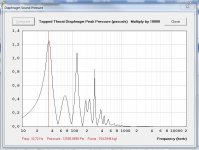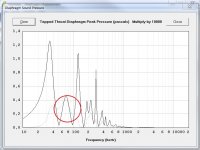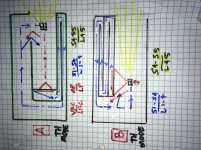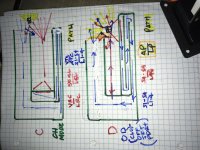Paraflex, Transflex, rear vented qw pipes.... ROAR, compound horn, offset port QW pipes and horn shapes....
Bring it! And bring your buddies too.
These things are too much fun. Even if quite complex and even a PITA to try and design your own, the fun is undeniable, and if you get it just right, and it’s your type of sound, wow can it be rewarding!
Maybe this can be ‘that thread’? Diy supercalifragilistic -pipe/horn- alidociius?
No names. But if you are affiliated with any of these things, let me say from the bottom, the nooks and crannies of my heart, the very most sincere thank you, and respectful appreciation for what you have shown me or made available to see for all.
for all.
My hopes here are to try and make Horn Response allow me (and anyone)to accurately portrait these types of ideas . Not per the name or it’s creators vision, I cannot claim to do this perfectly or am. That is respected. But those are key examples of very functional versions and similar in many ways, yet Entirely different too..
Adding pics below...
Bring it! And bring your buddies too.
These things are too much fun. Even if quite complex and even a PITA to try and design your own, the fun is undeniable, and if you get it just right, and it’s your type of sound, wow can it be rewarding!
Maybe this can be ‘that thread’? Diy supercalifragilistic -pipe/horn- alidociius?
No names. But if you are affiliated with any of these things, let me say from the bottom, the nooks and crannies of my heart, the very most sincere thank you, and respectful appreciation for what you have shown me or made available to see
 for all.
for all.My hopes here are to try and make Horn Response allow me (and anyone)to accurately portrait these types of ideas . Not per the name or it’s creators vision, I cannot claim to do this perfectly or am. That is respected. But those are key examples of very functional versions and similar in many ways, yet Entirely different too..
Adding pics below...
They’re kind of hard to sort out and define. There’s two qw paths (blue/red)or Helmholtz in some, and then a series (yellow) or parallel version. I think the most difficult part comes down to the taped horn versions? I think I’m going to try and use a version much like a FLH with a vented rear chamber. Exp flare broken into 3 PAR segments. The rear vented will be a qw path too. I can get them to over lap but the response is pretty haggered in TH mode. Better in CH, but I think it’s just because you get more segments to describe and it’s not actually a series BP type of layout?
I love these high order QW designs, but I want to focus a little on the thoughts behind the design and the positive acoustic feedback of the ROAR-designs.
The ROAR has a few aspects that in my humble opinion sets it apart from many of the other high order QW designs out there.
The first is the split path symmetrical loading. It might increase the complexity and weight a bit, but at high power levels it really makes a large difference.
Even modern drivers like the 15-18-21-DS115 and 18-21IPAL series does not like warping non-even loads the makes the voice-coil scratch the sides of the magnet system. This does not matter much below a few hundred watts but as the suspension loosens from heavy use, stretch, wear and heat and the power levels starts to climb the load on the cone can easily destroy a driver.

Cone pressure at 2700 watt into a 18IPAL in a ROAR design.
With 150 kg peak pressure changing direction 67 times a second you really want to load your driver as evenly as possible. Try standing with all your weight on one foot on one side of the cone of a driver if you doubt the importance of this.
The ROAR has a few aspects that in my humble opinion sets it apart from many of the other high order QW designs out there.
The first is the split path symmetrical loading. It might increase the complexity and weight a bit, but at high power levels it really makes a large difference.
Even modern drivers like the 15-18-21-DS115 and 18-21IPAL series does not like warping non-even loads the makes the voice-coil scratch the sides of the magnet system. This does not matter much below a few hundred watts but as the suspension loosens from heavy use, stretch, wear and heat and the power levels starts to climb the load on the cone can easily destroy a driver.

Cone pressure at 2700 watt into a 18IPAL in a ROAR design.
With 150 kg peak pressure changing direction 67 times a second you really want to load your driver as evenly as possible. Try standing with all your weight on one foot on one side of the cone of a driver if you doubt the importance of this.
The positive acoustic feedback inherent in the ROAR design kind of increases the (virtual) Bl of the driver.
This is mostly seen in the very important midbass region where most of the energy in modern music resides.

The grey curve is the cone pressure at the very beginning of the front resonator. The black curve is the pressure at the start of the tapped pipe section.
Since the large front resonator has a quite large bandwidth, it will add a large wide peak of positive acoustic feedback, centered around its fundamental quarter wave resonance. This will be added through the driver and kind of virtually add to the Bl of the driver in the frequency band where it is most needed.
I would guess this explains the very hard, punchy attack in the midbass region of the ROAR. It makes it sound quite similar to large well designed front loaded horns. Positive feedback does have its own special character, and I recognize this same character from when I have been experimenting with negative output impedance amplifiers. It does add a very firm, tactile and physical "strength" to the sound that I find very musical, life like and addictive. Once you get over the initial surprise, you don´t want to do without it (IMHO).
The feedback we have got so far from people who have built a ROAR design is very positive (some pun intended) and encouraging, with frequent use of rather nice superlatives.
This is mostly seen in the very important midbass region where most of the energy in modern music resides.

The grey curve is the cone pressure at the very beginning of the front resonator. The black curve is the pressure at the start of the tapped pipe section.
Since the large front resonator has a quite large bandwidth, it will add a large wide peak of positive acoustic feedback, centered around its fundamental quarter wave resonance. This will be added through the driver and kind of virtually add to the Bl of the driver in the frequency band where it is most needed.
I would guess this explains the very hard, punchy attack in the midbass region of the ROAR. It makes it sound quite similar to large well designed front loaded horns. Positive feedback does have its own special character, and I recognize this same character from when I have been experimenting with negative output impedance amplifiers. It does add a very firm, tactile and physical "strength" to the sound that I find very musical, life like and addictive. Once you get over the initial surprise, you don´t want to do without it (IMHO).
The feedback we have got so far from people who have built a ROAR design is very positive (some pun intended) and encouraging, with frequent use of rather nice superlatives.
Yes, and yes, and another yes! And what a great representation of one of the MOST exciting types of bass making cabinets I can think of. Also one unique in the amount of ‘series’ path used after the front output is directed over the motor. These are all tricky to setup, and they all have a potential issue inthe overlap and resulting response/phase and GD, but done ‘correctly’ and WOW! Amazing impact, and something brutally powerful seems to smack you in the 40-80hz region or so that’s undeniably addictive to many people.
Larger cones tilt and uneven loading issues important here!. And split path is great for making flare rates and smooth aggressive CSA increases. A thing to very much consider in design/build. I often wonder if a big 90 degree turn (if looking from the side through the long dimension off an end could make these designs work behind a couch, in the back of an SUV, or even into a corner of a HT application if stood on end(small footprint) ,etc...
Larger cones tilt and uneven loading issues important here!. And split path is great for making flare rates and smooth aggressive CSA increases. A thing to very much consider in design/build. I often wonder if a big 90 degree turn (if looking from the side through the long dimension off an end could make these designs work behind a couch, in the back of an SUV, or even into a corner of a HT application if stood on end(small footprint) ,etc...
Last edited:
Yes, and yes, and another yes! And what a great representation of one of the MOST exciting types of bass making cabinets I can think of. Also one unique in the amount of ‘series’ path used after the front output is directed over the motor. These are all tricky to setup, and they all have a potential issue inthe overlap and resulting response/phase and GD, but done ‘correctly’ and WOW! Amazing impact, and something brutally powerful seems to smack you in the 40-80hz region or so that’s undeniably addictive to many people.
Larger cones tilt and uneven loading issues important here!. And split path is great for making flare rates and smooth aggressive CSA increases. A thing to very much consider in design/build. I often wonder if a big 90 degree turn (if looking from the side through the long dimension off an end could make these designs work behind a couch, in the back of an SUV, or even into a corner of a HT application, etc...
Larger cones tilt and uneven loading issues important here!. And split path is great for making flare rates and smooth aggressive CSA increases. A thing to very much consider in design/build. I often wonder if a big 90 degree turn (if looking from the side through the long dimension off an end could make these designs work behind a couch, in the back of an SUV, or even into a corner of a HT application, etc...
- Home
- Loudspeakers
- Subwoofers
- Paraflex for dummies...and things very SIMilar

